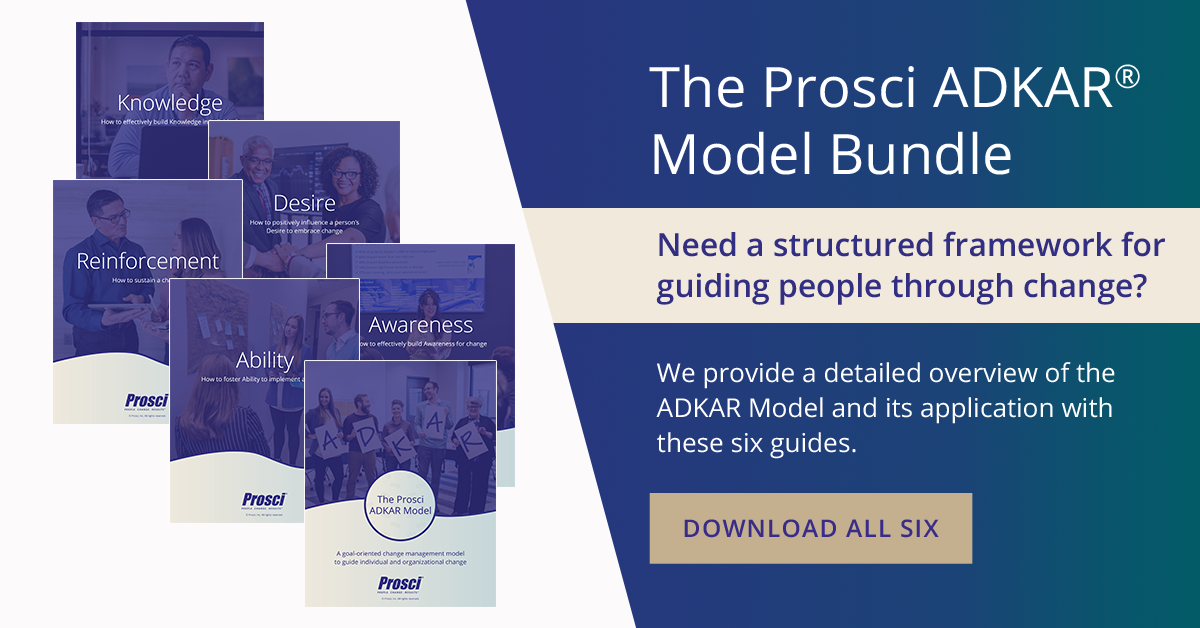The ADKAR Model: Building Desire for Change With One-on-One Coaching

3 Mins
Updated: February 13, 2023
Published: May 24, 2016

Once you build awareness of the need for a change, the first element in the Prosci ADKAR Model, we move on to the Desire. But building the second element of the Prosci ADKAR Model is not always easy.
I would much rather articulate the business reasons for a change or define a training strategy—that’s nowhere near as messy as figuring out how to influence someone’s desire to change.
Desire is personal. It can be a vulnerable and sometimes time-consuming process. And ultimately, we can’t make anyone decide to engage with and adopt a change. We can only understand their barriers and attempt to remove them. Yet, without people making the personal choice to participate in a change, other efforts to help people transition may be futile. We have to get into the tricky business of building Desire.
There are several ways to influence desire but I want to talk about one of the most effective ways to address a Desire barrier: a one-on-one coaching conversation between manager and employee. Let me tell you a story about Barrier Bob.
Barrier Bob
Barrier Bob is a respected senior analyst on my team who supports the ERP system. The current system was once best-in-breed but is now dated and inflexible. The company’s growth strategy includes acquisition, and the system will make integrating acquired businesses into our operations nearly impossible. Leadership has decided it’s time to evaluate a new system.
Since Bob has been instrumental in developing the current system and processes, he is invited to a discussion with senior leadership about how to move forward. During the meeting, Bob verbally agrees with the new direction. He takes the action items of conducting a SWOT Analysis on the current system and reaching out to his network for recommendations.
Yet, a couple of weeks after the meeting, I notice Bob has not made any progress. This is unlike him. Dragging his feet isn’t Bob’s style.
The Coaching Conversation
I pull Bob aside to ask what he really thinks of moving to a new system. He hesitates, then explains that he does not fully understand the need to move to a new system. The current system has served the business well, and Bob is proud of that. He also expresses worry about keeping up with the new technology and asks, “What if people stop seeing me as an expert?” Finally Bob adds, as an afterthought, that his mother’s health is failing, and he and his wife have their hands full helping her. He’s tired and the thought of this major change is overwhelming him.
Clearing the Barriers
Bob's explanation revealed several barriers to his desire to buy into the new direction, and we discussed each in turn:
1. Bob isn’t buying the “why”
This is a crossover of lack of Awareness and Desire. I realize Bob wasn’t involved in the preceding discussions about the current system limiting company growth. I took time to discuss this with him, and we were able to identify together why the current system would make it difficult to acquire another company. This helped Bob internalize the why.
2. Bob has pride in the current state
I assure Bob that his hard work over the years is not unnoticed or unappreciated. In fact, it is what led us to involve him in planning for the future. Sometimes, people need to be reassured that their work in the current state has been valuable, even if the company is moving in a different direction.
3. Bob fears he will not be as proficient or seen as an expert
I assure Bob that I am confident in his ability to master a new system and commit to investing in his training, so he can continue to act as a subject matter expert in the team.
4. Bob is dealing with an unrelated personal challenge
The personal challenge of his mother’s health is impacting Bob’s ability to process and buy into the change. I thank him for sharing this with me and ask if there’s anything we can do to reduce his stress and free up some emotional and mental capacity. He says working from home two days a week would help him greatly. We make the necessary arrangements to accommodate his request.
Now, the reality is that coaching conversations are not always this tidy. This is meant to be an example. Also, a single coaching conversation is not always sufficient to help someone overcome their Desire barrier. Bob may need time to process what we talked about. As Bob's leader, I will need to keep an eye on the issues we’ve talked about and circle back if I see or sense him withdrawing from the process again.
However, in this initial coaching conversation, I have accomplished two important things: 1) I have demonstrated that I’m willing to dig into the issues holding Bob back and 2) I now have a list of things to be mindful of as we move forward together. I know what Bob is up against, and I can keep those issues in mind as I continue to coach and communicate.
Managers Are the Linchpin
These kinds of conversations can only happen with the trust and mutual respect typically found in a manager-employee relationship. In change initiatives, we cannot rely on the project manager, change manager or even sponsor to have these connections. We really need people managers to be effective coaches of change. They must be skilled at having conversations that reveal the barriers to change and empowered to take action to remove those barriers.
Consider how you leverage managers as coaches during change. Do your people leaders understand their role in building Desire? Do they have the tools and ability to identify and remove barriers? Building Desire is tricky business. Equip managers to coach their employees through their barriers to Desire, and you can greatly influence this requirement for individual change.


